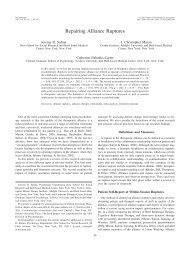Download - The Safran Lab
Download - The Safran Lab
Download - The Safran Lab
You also want an ePaper? Increase the reach of your titles
YUMPU automatically turns print PDFs into web optimized ePapers that Google loves.
analyst's role in permitting the client to form an attachment to the analyst (vis-a-vis<br />
transference). Freud perceived the attachment between the therapist and patient as a<br />
distortion of reality. He believed that it was the therapist's job to interpret the erroneous<br />
perceptions that the client transferred onto the therapist and that analyzing these<br />
perceptions was critical to the therapy and to the patient's improvement. Thus, while a<br />
good relationship was essential to the therapeutic process, it was a source of<br />
interpretation for the therapist. Later, however, Freud modified his earlier perception of<br />
the therapist-patient relationship from a distortion of the real relationship to include a<br />
reality-based attachment in which healing takes place.<br />
Sterba (1934) and Zetzel (1956) provided the groundwork on which the concept<br />
was developed. Sterba wrote of the need for the analyst to form an "alliance" with the<br />
patient's ego against the forces of unconscious impulses in order to make progress in<br />
analysis. Sterba was first to emphasize the importance of rationality and objectivity in<br />
therapy. Zetzel distinguished between the "transference neurosis," which she defined as a<br />
manifestation of resistance, and the "therapeutic alliance," which she considered to be an<br />
essential component of successful psychoanalytic treatment.<br />
Bibring (1954) suggested that the therapeutic situation represents a "new object<br />
relationship." In other words, the patient is able to form an attachment to the therapist<br />
that is different from those the patient formed during past childhood experiences,<br />
suggesting that the perception of the relationship is malleable rather than fixed.<br />
5



